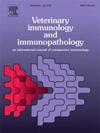解决流式细胞仪表征猪 CD8α/β 表达淋巴细胞的技术问题
IF 1.4
3区 农林科学
Q4 IMMUNOLOGY
引用次数: 0
摘要
CD8 分子是一种细胞表面受体,是 T 细胞的共受体,可直接与抗原呈递细胞上的主要组织相容性复合体 I 类结合。CD8 抗原由两条不同的多肽链组成,即 α 和 β 链。在猪体内,CD8 受体由多个淋巴细胞亚群表达,包括自然杀伤细胞、γδ T 细胞和有抗原经验的 CD4+ αβ T 细胞。在这些细胞群中,CD8 以 αα 同源二聚体的形式表达。另一方面,猪细胞溶解 T 细胞只表达 CD8 αβ 异二聚体。有几种针对这两种链的单克隆抗体(mAbs)可供选择,并常用于流式细胞术。我们观察到,CD8α 和 CD8β 链 mAb 克隆的不同组合会给多色染色板带来麻烦。因此,我们旨在深入研究不同 CD8 特异性 mAb 克隆的用法,并优化流式细胞仪的共染色策略。我们测试了用于检测 CD8α 的 mAb 克隆 11/295/33 和 76-2-11,以及用于检测 CD8β 的 mAb 克隆 PPT23 和 PG164A。结果表明,CD8α克隆 11/295/33 不应与两个 CD8β 克隆中的任何一个在同一孵育步骤中同时使用,因为共同染色会导致 CD8β mAb 结合能力大大降低,并在流式细胞仪中失去信号。这可能导致检测 CD8αβ 细胞溶解 T 细胞的错误结果。就 CD8α mAb 克隆 76-2-11 而言,没有观察到任何一种 CD8β mAb 克隆的结合受到抑制,因此它是多色染色面板的首选。所获得的数据将有助于今后猪流式细胞仪的面板设计,从而改进猪免疫细胞的研究。本文章由计算机程序翻译,如有差异,请以英文原文为准。
Solving technical issues in flow cytometry to characterize porcine CD8α/β expressing lymphocytes
The CD8 molecule is a cell surface receptor and well described as co-receptor on T cells, binding directly to the major histocompatibility complex class I on antigen presenting cells. CD8 antigens are comprised of two distinct polypeptide chains, the α and the β chain. In the pig, the CD8 receptor is expressed by several lymphocyte subsets, including Natural Killer cells, γδ T cells and antigen experienced CD4+ αβ T cells. On these cell populations CD8 is expressed as αα homodimers. Porcine cytolytic T cells on the other hand exclusively express CD8 αβ heterodimers. Several monoclonal antibodies (mAbs) for either of the two chains are available and are frequently used in flow cytometry. We observed that distinct combinations of mAb clones for CD8α and CD8β chains can cause troubles in multi-color staining panels. Therefore, we aimed for an in-depth study of the usage of different CD8-specific mAb clones and optimizing co-staining strategies for flow cytometry. We tested mAb clones 11/295/33 and 76–2–11 for the detection of CD8α and mAb clones PPT23 and PG164A for the detection of CD8β. The results indicate that the CD8α clone 11/295/33 should not be used together with either of the two CD8β clones in the same incubation step, as co-staining led to a highly reduced ability of CD8β mAb binding and loss in signal in flow cytometry. This can lead to potential false results in detecting CD8αβ cytolytic T cells. In case of the CD8α mAb clone 76–2–11, no inhibition in binding of either CD8β mAb clones was observed, making it the preferred choice in multi-color staining panels. The obtained data will help in future panel designs for flow cytometry in the pig and therefore improving studies of porcine immune cells.
求助全文
通过发布文献求助,成功后即可免费获取论文全文。
去求助
来源期刊
CiteScore
3.40
自引率
5.60%
发文量
79
审稿时长
70 days
期刊介绍:
The journal reports basic, comparative and clinical immunology as they pertain to the animal species designated here: livestock, poultry, and fish species that are major food animals and companion animals such as cats, dogs, horses and camels, and wildlife species that act as reservoirs for food, companion or human infectious diseases, or as models for human disease.
Rodent models of infectious diseases that are of importance in the animal species indicated above,when the disease requires a level of containment that is not readily available for larger animal experimentation (ABSL3), will be considered. Papers on rabbits, lizards, guinea pigs, badgers, armadillos, elephants, antelope, and buffalo will be reviewed if the research advances our fundamental understanding of immunology, or if they act as a reservoir of infectious disease for the primary animal species designated above, or for humans. Manuscripts employing other species will be reviewed if justified as fitting into the categories above.
The following topics are appropriate: biology of cells and mechanisms of the immune system, immunochemistry, immunodeficiencies, immunodiagnosis, immunogenetics, immunopathology, immunology of infectious disease and tumors, immunoprophylaxis including vaccine development and delivery, immunological aspects of pregnancy including passive immunity, autoimmuity, neuroimmunology, and transplanatation immunology. Manuscripts that describe new genes and development of tools such as monoclonal antibodies are also of interest when part of a larger biological study. Studies employing extracts or constituents (plant extracts, feed additives or microbiome) must be sufficiently defined to be reproduced in other laboratories and also provide evidence for possible mechanisms and not simply show an effect on the immune system.

 求助内容:
求助内容: 应助结果提醒方式:
应助结果提醒方式:


